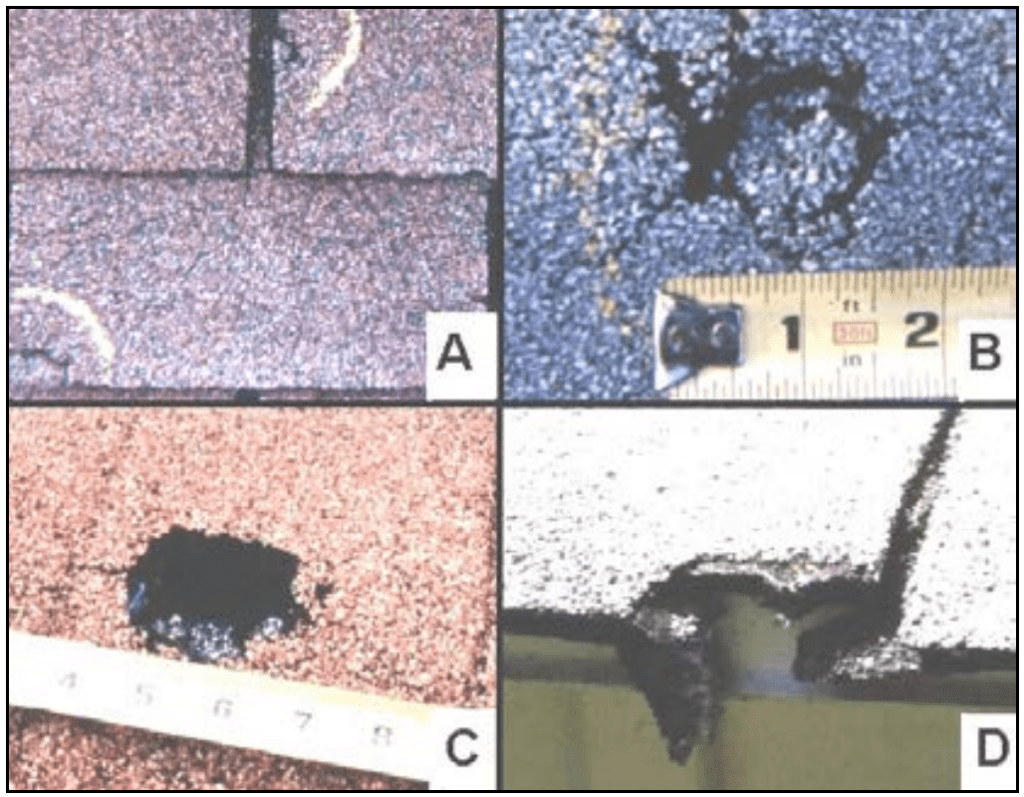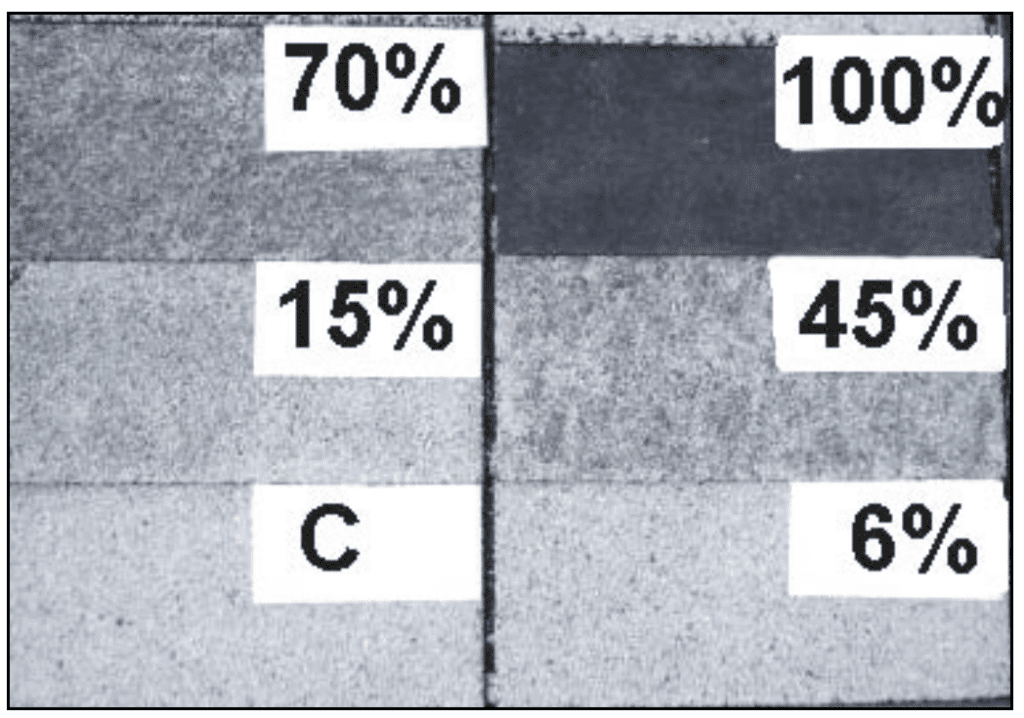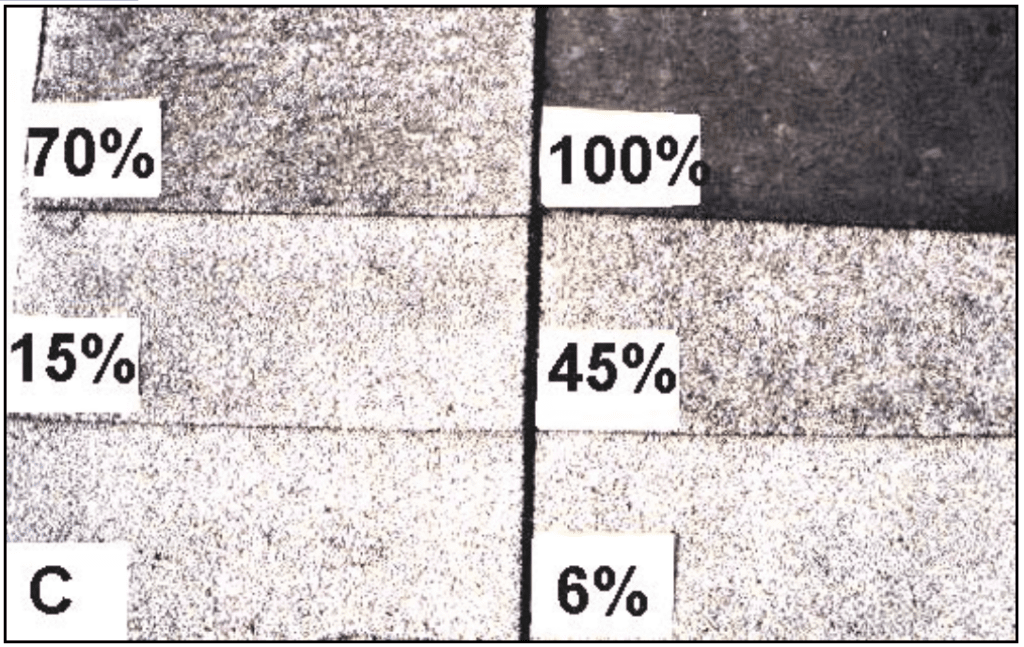
Hail Damage
Controversies can arise with regard to how asphalt shingles are damaged by hail, and what hail damage actually looks like. More specifically, questions have been raised as to whether granules removed from asphalt shingles during a hailstorm will reduce the
expected life or water shedding ability of the roof shingles.
Timothy P. Marshall, Richard F. Herzog, and Scott J. Morrison
Haag Engineering Co.
Dallas, Texas
1. INTRODUCTION
In this article, the authors will review the definition of hail damage to asphalt shingles and explain the characteristics of such damage. We also will present the results of our ten-year study on granule loss to asphalt shingles as well as review the methodology to assess hail damage to an asphalt shingle roof.
The authors have inspected thousands of asphalt shingle roofs and found that damage inspectors frequently mistake various shingle anomalies such as foot scuffs, adhesive spots, etc., as hail damage. We have also inspected numerous roofs where people have tried to simulate hail damage by using a variety of tools or other objects in order to defraud an insurance carrier. Therefore, the last part of this paper will focus on various shingle anomalies that are frequently misidentified as hail damage and explain how to differentiate between intentional and unintentional roof damage.
2. ASPHALT ROOF SHINGLE COMPONENTS
Asphalt roof shingles are one of the most common and affordable roof coverings on the market today. Base mat materials are either paper (organic) or glass-fiber (inorganic). The mats are coated with an asphaltic mixture composed of asphalt, limestone powders, and other mineral stabilizers (fillers). Granules are applied to the shingle surfaces to give them color, add weight, and to block the underlying asphalt from deleterious effects of the sun. Most granules are crushed stone coated with a ceramic material. The ceramic gives color to the granules. Generally, one third of the shingle weight is granules, one-third asphalt, and one-third filler. The mat is a small fraction of the total weight.
Asphalt roof shingles come in various sizes, shapes, and thicknesses. Generally, the thicker or heavier the asphalt shingle, the more it costs. The most common asphalt shingles are three-tab and laminated varieties. Three tab shingles contain slots or joints that give the appearance of a common brick pattern when installed on the roof. Laminated type shingles are comprised of one full shingle and half a shingle bonded together with asphalt to give them thicker look, similar to that of wood shingles or slate.
Three-tab shingles contain slots or joints that give the appearance of a common brick pattern when installed on the roof. Laminated type shingles are comprised of one full shingle and half a shingle bonded together with asphalt to give them thicker look, similar to that of wood shingles or slate.
3. HAIL DAMAGE DEFINITION
Morrison (1999) defined damage to roofing as a diminution of water-shedding capability or a reduction in the expected long-term life of the roofing material. Marshall and Herzog (1999) more specifically defined functional hail-caused damage to asphalt shingles as punctures, tears, or fractures (bruises) in the shingle mats (Figure 1). Shingle bruises are an indentation with fracture in the mat that feels soft like that of an apple bruise. The bruise is usually obvious as granules are also dislodged from the impact area exposing the asphaltic mat.
Marshall et al. (2002) presented their ice impact test results that employed a mechanical launching device. Ice stones were launched at standard velocities against roofing products that included various 11-year-old, naturally aged, asphalt shingles. Impacts were oriented perpendicular to the shingles. The study concluded that aged organic mat-based asphalt shingles were damaged half of the time by one-inch diameter ice stones, whereas it took 1.25 in. (3.1 cm) diameter ice stones to damage the aged glass-fiber mat asphalt shingles. Thicker, aged, laminated type shingles were damaged by 1.5 in. (3.8 cm) ice stones. Greenfeld (1969) and Koontz (1991) had presented similar results in conducting ice ball impact tests on asphalt shingles.

However, there remains a controversy whether granules removed by hail, without visible asphalt exposure, constitutes hail damage. Many asphalt shingle manufacturers have issued “technical bulletins” about hail and granule loss, stating that if granules are lost from the shingle due to hail, the shingle has lost life. However, there are no published scientific studies to validate this statement.
4. GRANULE LOSS STUDY
In order to determine how many granules, if any, must be removed in order to affect the service life or water shedding ability of the shingle, the authors’ firm conducted a granule loss study on asphalt shingles. Varying quantities of granules were removed with a wire brush from new, three-tab, glass-fiber mat shingles. The shingles then were exposed naturally to the weather in Dallas, Texas for a period of ten years. The quantities of granules removed were none (control), and approximately 6, 15, 45, and 70 percent of the total granules on the shingles. Another shingle was installed upside down such that the asphaltic mat was exposed to the weather. The shingles were installed conventionally over a plywood deck on a 4:12 pitch that faced south. The shingles were examined at intervals throughout the ten-year period as well as at the conclusion of the study (Figures 2 and 3).


In one year, the exposed asphalt had oxidized grey but there was no visible evidence of surface cracks or erosion. After five years, areas of exposed asphalt had oxidized but this did not affect the function of the shingles to shed water. Surface erosion was visible on the shingle without granules, and some of the glass fibers had become exposed. After ten years, no significant change was noted in the shingles except for the shingle without granules. More glass fibers were exposed on this shingle due to erosion; but, the shingle continued to shed water (Figure 4).

The quantity of granules lost from the roof shingles during a hailstorm is a relatively small amount. Generally, about one-third the weight of an asphalt shingle is granules such that a 25 square roof covered with three-tab shingles would have about one ton of granules. Granule loss is expected from the moment shingles are manufactured, shipped, installed, and during the weathering process. Granules are part of the wearing surface on the shingle and exposure to hail is part of the wearing process that is actually built into the design. Thus, more granules are initially placed on the shingles than needed to cover the mat.
In our study, we found between 12 to 15 percent of the surface granules had to be removed from new shingles before the asphaltic mat was exposed. The amount of “excess” granules on new shingles varied by plus or minus ten percent. We would expect that the quantity of granules lost during a hailstorm generally would fall within the normal variation of granules placed on a shingle.
Therefore, it seems logical to conclude that the small quantities of granules removed from shingles during a hailstorm does not shorten the life of the roof or adversely affect its water shedding ability as long as the impacted areas are not bruised or punctured and remain covered with granules. This conclusion agrees with the work done by Morrison (1999).
5. ASPHALT SHINGLE ANOMALIES
There are usually a number of anomalies on an asphalt shingle roof not related to hailstone impact. Some of these anomalies may take rounded forms that can be mistaken as hail damage. Understanding how shingles are manufactured, installed, and weather is important when properly differentiating between non-hail conditions and hail damage.
Asphalt shingles are manufactured in a high speed, fully automated process. Occasionally, certain defects involve insufficient granule or asphalt coverage, or the use of poor-quality asphalt. Shingle manufacturers should “cull” or remove such defects before the shingles are shipped. However, the level of quality control of shingle products varies. Thus, it is not unusual to find shingle defects on a roof that involves bands or spots of missing asphalt and/or granules (Figure 5).

As asphalt shingles age, their components break down. The extent of aging depends upon many factors including the quality of the asphalt, shingle color, roof pitch, slope direction, and attic ventilation. Common deficiencies inherent with aged asphalt shingles are blistering, splitting, cupping, clawing, crazing, and flaking. In many instances, these anomalies are not discovered until after a hailstorm; however, this does not mean they were created or
aggravated by the storm (Figures 6 and 7).

Shingle blisters occur from a combination of poor-quality asphalt combined with heat. They appear as small bubbles in the shingle surfaces where a portion of the granule surface is raised. Eventually, the shingle bubbles rupture exposing steep-sided voids in the shingle surfaces that frequently extends down to the shingle mat. Shingle blisters are usually 1/4 in. (.6 cm) in diameter or less and are not caused by hailstone impact.
Diagonal and horizontal splitting of asphalt shingles involves a combination of asphalt shrinkage, deck movement, and low tensile strength in the mat. Ribble et al. (1993) further explains such problems with asphalt shingles.

Cupping and clawing results from asphalt shrinkage on the top and bottom surfaces of the
shingles, respectively. The corners and edges of the shingles are prone to curling or cupping as the mat shrinks. Crazing of the shingle surfaces also results from asphalt shrinkage. Eventually, chunks of granules flake away from the mat leaving the asphalt coated mat exposed to the weather.
Additional shingle anomalies can be created during installation. The most common shingle installation deficiencies are marring, edge scuffing, elevated staples, and adhesive spots (Figure 8).

Shingle marring occurs when people walk across the roof on a day when the shingles are hot, soft, and pliable. The asphalt in the shingle surface softens to the point where it is pushed aside along with the granules and typically forms a ridge on the outside edge of the mark. Persons walking on the roof can also remove granules along the bottom edges of the
shingles.
Elevated fasteners can occur during the installation of the shingles and can protrude through or buckle the overlying shingles. The fasteners are either not driven flush to the shingle or are driven into joints between the roof decking. Elevated fasteners are not caused by hail striking the roof.
Adhesive can drip off the shingles onto the other shingles leaving a round, dark spot that can be mistaken by some as hail damage. If the adhesive from one shingle contacts another shingle and bonds to it, a portion of the shingle surface can be removed when the shingles are separated leaving a rounded area of missing granules that can also be mistaken by some as hail damage.
6. ASSESSING HAIL DAMAGE
Accurate assessment of hail damage is a step-by-step process that involves an examination of the roof shingles as well as other objects on and around the roof. Marshall and Herzog (1999) presented a methodology on how to quantify hail damage to a roof through the use of test squares. The number of hail damaged shingles are counted in each test square on each directional roof slope and that number determines whether the roof slope is repaired or
replaced through the use of the DURA formula. Shingles are particularly susceptible to hail
damage if they have little or no underlying support, especially along ridges, rakes, eaves, and valleys. Shingle edges also are vulnerable to being chipped or broken. Therefore, the entire roof must be examined. Recently exposed asphalt appears black or unweathered, whereas asphalt exposed for several months oxidizes forming a surface film that is a grey color. This color difference is one way to tell new hail damage from old hail damage (Figure 9).

7. INTENTIONAL MECHANICAL DAMAGE
On occasion, some people have utilized various tools or other objects in an attempt to simulate hail damage on a roof. Popular items have included: 1) ball peen hammers, 2) claw hammers, 3) coins, and 4) screwdrivers. The authors have recognized a number of factors that distinguish intentional damage from hail damage. For example, intentional damage is not randomly distributed on the roof but usually occurs in groups or lines concentrated in upper portions of the roof, away from roof edges. Impact angles of the tool or object are nearly perpendicular to the affected roof slope, therefore indicating multiple impact directions (Figure 10). In contrast, hail would leave a random distribution of damage on the roof. The windward slope typically sustains the most concentrated and direct hail impacts whereas the leeward slopes have fewer, glancing hail impacts.

Intentional damage is concentrated frequently in the interior or center portions of the shingles, away from shingle edges, as it is human nature to hit the center of an object. Such centered impacts usually are found on each affected slope, regardless of slope direction (Figure 11).

The impacts tend to be singular, occurring once per shingle. In contrast, hail does not prefer the centers of the shingles nor strike shingles once consistently.
In our inspections of suspicious roof damage, we utilize a series of magnification rings to closely photograph the impact marks. Typically, shingles struck by metal objects will have broken or shattered the ceramic coating on the granules. This will leave a “powder” residue containing shattered ceramic material within the impact mark. Any side-to-side or “rounding out” motions will tend to leave swirl marks within the powder residue and/or leave smudges in the exposed asphalt surface (Figure 12).
When claw hammers are utilized, the metal peen frequently does not strike the roof slopes exactly perpendicular but tends to tilt forward slightly leaving a characteristic curving fracture in the shingles that opens towards the direction of impact. The concave fracture in the shingle resembles a “frowny” face when looking upslope. Granules closest to the concave side of the fracture are frequently compressed uniformly into the shingle mat.
Sometimes coins are utilized to leave small divots in the shingle surface. Quarter coins have small ridges around their perimeters that can leave a series of ridges in the asphalt under magnification.

8. DOCUMENTING INTENTIONAL DAMAGE
The authors have developed a methodology to better document intentional damage to a roof. The procedure involves examining objects around and on the house similar to the hail damage inspection protocol as explained by Marshall and Herzog (1999). Hail-caused “spatter” marks are usually found on faded metal surfaces such as air conditioners, electrical junction boxes, and metal window frames. Hail-caused “scuff” marks are recorded on wooden fences and dents occur in aluminum fins on air conditioners. Such items provide good estimates of hail size and direction of hailfall. The same can be said with the examination of metal items on the roof. Thus, items on and around the house can provide evidence of hail size and direction that should match the size and direction of any alleged hail damage to the roof shingles.
After a general examination of the building surroundings is performed, a roof plan diagram is drawn, and shingle marks are plotted. Any pattern or grouping of shingle marks quickly becomes apparent in the diagram (Figure 13). The diagram will indicate those roof slopes or ridges that are notably without shingle marks as well as any grouping of marks. Usually, large areas of the affected roof slopes are without shingle marks as are other, perhaps smaller, roof slopes that face the same direction. Shingle marks closest to the roof edge are measured.

SUMMARY
In this article, we have explored certain issues with regard to hail damage on asphalt roof shingles. The results of our ten-year granule loss study were presented where it was found that there was no loss of life or reduction of water shedding ability even with 70% of the granules removed from the glass-fiber mat shingles. The shingle with 100% of the granules removed did exhibit more erosion than the other shingles. Therefore, asphalt roof shingles that lose some granules during a hailstorm are not considered damaged as long as the shingles remain covered with granules. Functional damage to asphalt roof shingles includes punctures, tears, or fractures (bruises) in the shingle mats.
We also have shown there are a number of anomalies on asphalt shingles that occur during manufacturing, installation, and weathering. Some of these anomalies take on rounded forms that can be mistaken by some as hail damage. We also have discussed how to recognize intentional damage to asphalt roof shingles where someone attempts to simulate hail-caused damage. A methodology was presented to better document intentional damage to a roof.